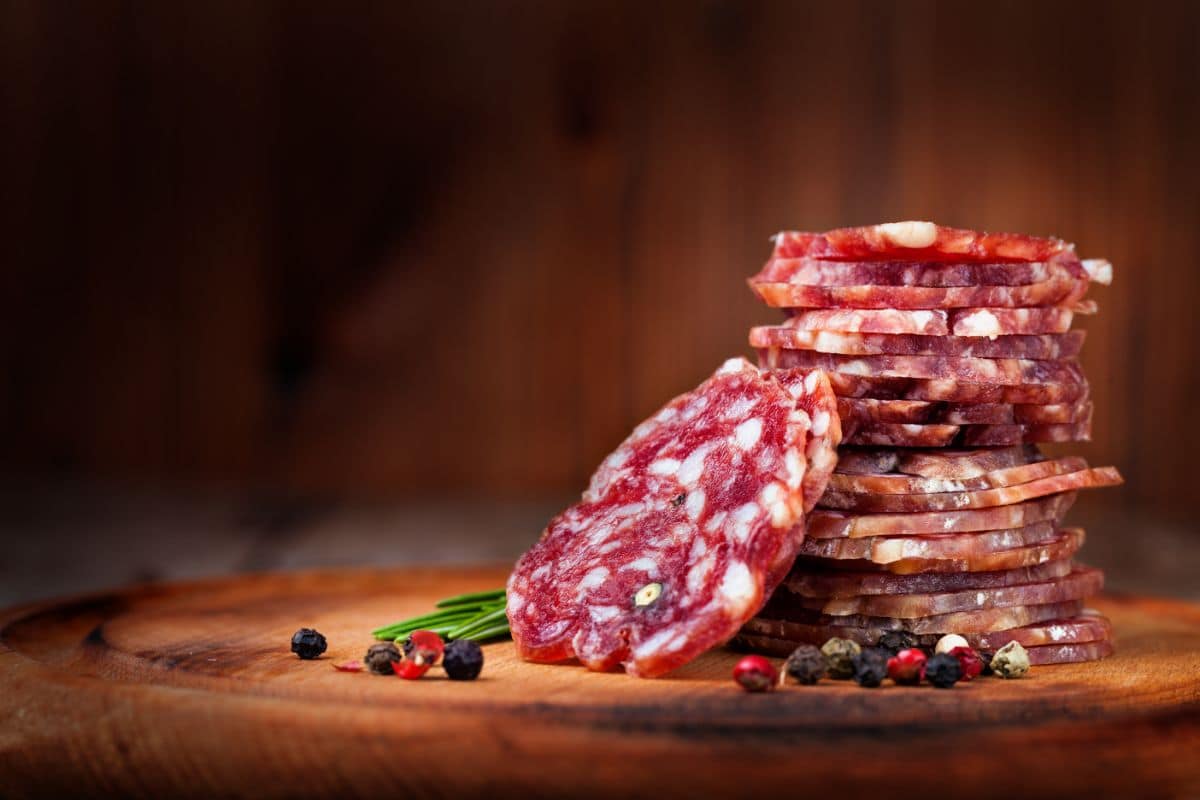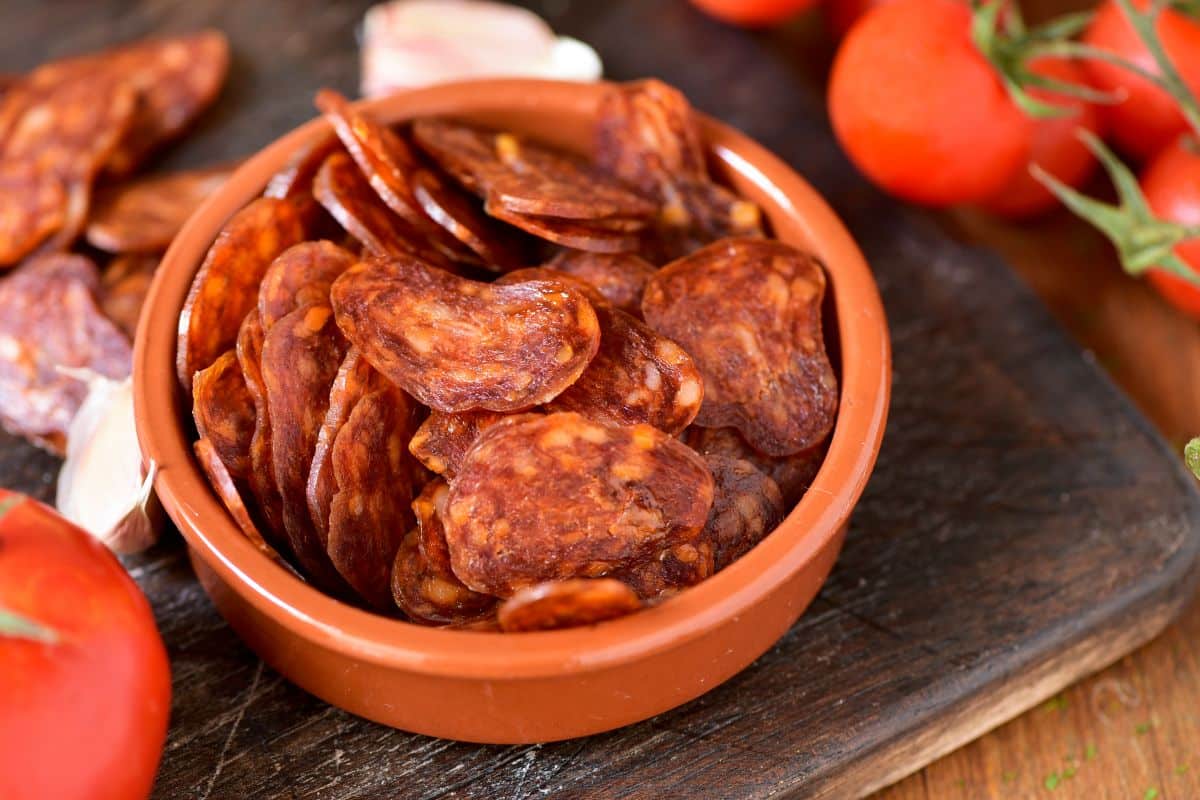When it comes to the world of spicy sausages, chorizo often finds itself in the spotlight. This popular meat from Spain and Portugal has found its way into kitchens and menus all over the world.
Its distinct flavor and versatility have won the hearts (and taste buds) of many food lovers.

But what if you’ve never tried Chorizo before? How can you be sure that you will like it before committing to purchasing some? If you’re wondering about this, then you’ve come to the right place!
In this article, we will delve into the world of chorizo and explore what it tastes like, as well as highlight a few foods that share similar flavor profiles.
What Is Chorizo?
Chorizo is a Spanish and Portuguese sausage that originated in the Iberian Peninsula. It is traditionally made with ground pork that has been seasoned with spices such as paprika, garlic, and chili powder.
The spices used can vary depending on regional preferences, resulting in different types of chorizo. Curing the sausage gives it a firm texture and allows it to be enjoyed both cooked and uncooked.
Chorizo is famous for its rich, bold flavors and vibrant red color, which is largely due to the generous use of paprika in its preparation.
The sausage comes in several varieties, including raw, semi-cured, and fully cured. Raw chorizo must be cooked before eating, whereas cured chorizo can be eaten without further preparation.
What Does Chorizo Taste Like?
Chorizo is often described as robust, savory, and slightly spicy. The combination of spices gives it a distinct flavor profile that distinguishes it from other sausages.
The predominant flavor is typically smoky, earthy, and slightly sweet. The level of spiciness varies depending on the type of chili powder used, but it usually adds a mild to moderate kick.
Chorizo releases aromatic oils when cooked, intensifying flavors and creating a delicious aroma. The sausage’s fat content adds richness and depth, resulting in a satisfying taste experience.
Cooked chorizo has a slightly crumbly texture, making it a versatile ingredient that can be used in a variety of dishes.
5 Foods That Taste Similar To Chorizo
So what if you’ve never eaten Chorizo before, but want to know more about what it tastes like?
We’ve provided you with a short explanation, but in this section, we want to give you some other foods that you may have tried that have a similar flavor profile to Chorizo.
Take a look at the list below to see if you recognize any of these foods.
Pepperoni
Pepperoni is an Italian-American sausage that resembles chorizo in some ways. It has a smoky, slightly spicy flavor, but it is typically less robust than chorizo. Pepperoni is a popular topping for pizzas and sandwiches.
Andouille Sausage
Andouille sausage, which originated in Louisiana, has a distinct flavor that is reminiscent of chorizo.
It’s made with smoked pork that’s been seasoned with garlic, onion, and a variety of spices, including paprika. Andouille sausage is popular in Cajun and Creole cuisine, particularly in jambalaya and gumbo.
Linguica
Linguica is a Portuguese sausage that has a flavor similar to chorizo. It is typically made with pork, paprika, garlic, and other spices.
Linguica has a robust and slightly spicy flavor that makes it a popular ingredient in Portuguese cuisine, where it is frequently used in stews, soups, and sandwiches.
Merguez
Merguez is a North African sausage with bold and spicy flavors that are similar to chorizo. It’s usually made with lamb or beef and seasoned with spices like cumin, coriander, and chili.
Merguez is often grilled or pan-fried and served with couscous or in sandwiches.
Longaniza
Longaniza is a Spanish sausage that has some similarities to chorizo. It is made of pork that has been seasoned with paprika, garlic, and other spices.
Longaniza is a popular ingredient in Spanish cuisine due to its smoky, slightly spicy flavor. It can be used in a variety of dishes, including paella, stews, and tapas.
Other Things You Should Know About Chorizo
While we have covered the basics of chorizo, there are a few additional things worth knowing about this delectable sausage. Let’s delve into some interesting facts and tips related to chorizo:

Regional Variations
The first thing to keep in mind when it comes to the flavor profile of this food, is that Chorizo comes in various regional variations, each with its own unique characteristics.
There are two types of Spanish chorizo: “chorizo picante” (spicy chorizo) and “chorizo dulce” (sweet chorizo). Picante is known for its spiciness, whereas dulce is known for its milder flavor.
Furthermore, different regions of Spain and Portugal have their own chorizo recipes and techniques, resulting in subtle differences in taste and texture.
Cooking Techniques
Chorizo can be prepared in a variety of ways, each of which alters the flavor profile depending on the desired outcome. It can be boiled or poached if you prefer a soft, juicy texture.
Grilling or pan-frying chorizo gives it a slightly crispy exterior while keeping the interior succulent. Cooked chorizo fat can be used to enhance the flavors of other ingredients in a dish, such as vegetables or rice.
Culinary Uses
The versatility of chorizo makes it a valuable ingredient in a variety of culinary applications. It can be served as a standalone dish or sliced and served as a flavorful snack or appetizer.
Chorizo is also commonly used as a pizza topping, in pasta dishes, in soups, stews, and casseroles, and as a filling for omelets and breakfast tacos. Its strong flavors can add depth and complexity to a variety of dishes.
Chorizo Oil
When cooking chorizo, flavorful oils are released that can be used to infuse dishes with its distinct flavor. Simply cook sliced chorizo in a pan until the fat renders and the slices become crispy to make chorizo oil.
Remove the chorizo slices from the oil and set aside. The resulting oil can be drizzled over dishes, used as a marinade, or used as a base for sautéing vegetables or cooking meats to add a burst of chorizo flavor.
Food Combinations
Chorizo complements a wide range of ingredients, allowing for limitless flavor combinations. It is frequently served with tomatoes, beans, potatoes, and eggs in Spanish cuisine.
Chorizo’s smokey and savory flavors complement cheeses such as Manchego and goat cheese. When it comes to beverages, chorizo pairs well with red wines, craft beers, and even a refreshing cider.
Health Considerations
Because of its high fat and calorie content, chorizo is a high-fat and high-calorie food.
While it can be consumed in moderation as part of a balanced diet, people with specific dietary restrictions or health concerns should limit their intake.
Check the ingredients list of chorizo products as well, as some may contain additives, preservatives, or high sodium levels which can negatively affect your health if consumed in large quantities.
Sourcing Chorizo
When shopping for chorizo, look for artisanal or locally made varieties for an authentic and high-quality experience.
Traditional techniques and high-quality ingredients are frequently used in these versions, resulting in superior flavor and texture. Unique and artisanal chorizo options can be found at specialty delis, farmers’ markets, and online sources.
Final Thoughts
Chorizo is a staple food in many parts of the world that adds a delightful punch to dishes, or can be enjoyed on its own.
We hope that this article has given you all the information you wanted to know about Chorizo and that you’re now more confident about how it tastes and whether or not it’s right for you.
If you still have some questions, make sure to check out our short FAQ section below.
Frequently Asked Questions
Depending on the type of chili powder used in its preparation, chorizo can range from mild to moderately spicy.
Some chorizo varieties may be spicier than others, so check the label or inquire about the spiciness level when purchasing or ordering chorizo.
It all depends on the chorizo. Some chorizos, especially fully cured ones, can be eaten raw. However, raw or semi-cured chorizo should be cooked before consumption to ensure it is safe to eat.
The good news is that there are vegetarian and vegan chorizo options on the market.
Plant-based ingredients, such as soy protein, seitan, or tofu, are typically combined with spices to mimic the flavors of traditional chorizo.
It won’t be exactly the same as Chorizo, but it will provide a similar flavor profile.
While substituting chorizo for other sausages may not provide the same flavor profile, you can experiment with other sausages such as those mentioned earlier in this article (pepperoni, andouille sausage, linguica, merguez, and longaniza) to achieve similar flavor experiences in your recipes.






